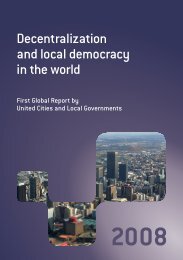Making Cities Resilient Report 2012
Making Cities Resilient Report 2012
Making Cities Resilient Report 2012
You also want an ePaper? Increase the reach of your titles
YUMPU automatically turns print PDFs into web optimized ePapers that Google loves.
CHAPTER 1 | Enabling conditions for building resilience<br />
<strong>Resilient</strong> urban planning<br />
The Urban Development Department implements the Comprehensive Land Use Plan (CLUP) and Zoning<br />
Ordinance (Z0) to ensure that new and existing facilities are CLUP and ZO-compliant before granting<br />
locational clearances, which is an innovative feature of the City’s permit application process. The Zoning<br />
Ordinance incorporates health and safety considerations and risk parameters into land use regulations.<br />
It requires, for example, an engineering, geological and geophysical assessment report for high-risk<br />
areas, although enforcement of this can be a challenge. Compliance with safe building codes is overseen<br />
by the Office of the Building Official, in cooperation with the private sector and professional ‘watchdog’<br />
organisations that conduct annual inspections, provide training and support in risk-sensitive planning and<br />
construction, and manage a certification mechanism.<br />
One concrete example of resilient site redevelopment planning is the Makati Risk Sensitive Urban<br />
Redevelopment Planning Project (RSURP), a pilot project undertaken in a high-risk Barangay (Barangay<br />
Rizal) that aims to reduce physical, social and economic vulnerability through comprehensive land use<br />
planning and disaster risk reduction.<br />
Health<br />
Disaster management is incorporated into healthcare in Makati through the Makati Emergency Medical<br />
Services Systems (MEMSS), which coordinates mass casualty operations. The emergency department<br />
of Ospital in Makati serves as the pilot agency for mobilising the flow of medical services, supported<br />
by Barangay health centres, which provide extension services. These have been assessed as ‘relatively<br />
safe’ according to ‘safe hospital’ indicators, meaning they will continue to function in case of disaster,<br />
have contingency plans and trained personnel. To help ensure public access to healthcare facilities in<br />
disaster situations, the city has implemented a HealthCard Programme as part of the wider Makati Health<br />
Programme. The HealthCard Programme is implemented citywide for all health care services and provides<br />
free medical and diagnostic services and a 50% discount on maintenance medicines.<br />
Coordination of disaster response across sectors<br />
The Makati Command, Control and Communications Centre (C3) is responsible for central coordination of<br />
early warning and emergency response. The C3 is a component of the Makati City Disaster Risk Reduction<br />
Management Office (Makati DRRMO), which is the implementing arm of the Makati Disaster Risk Reduction<br />
and Management Council (Makati DRRMC), chaired by the Mayor. The C3 acts as the city liaison between<br />
and among national government agencies, NGOs, private entities and communities in times of disaster,<br />
to issue warnings to communities and coordinate medical, public safety, and technical rescue responses.<br />
The C3 uses a variety of technologies for disaster management, including: real-time video surveillance;<br />
a GIS system to track patrol units, ambulances, and rescue vehicles; and a radio dispatch system to<br />
coordinate responses by monitoring and coordinating the distribution of resources.<br />
Risk governance at all scales<br />
A key factor in Makati’s resilience is the involvement of all levels and sectors of society, particularly<br />
the active role of Barangays, which exist at a sub-city level. Barangay Disaster Risk Reduction and<br />
Management Committees are the implementing arm of the Makati DRRMC at community level. Their<br />
multi-sectoral membership includes youth, environmental and women’s groups. Information, Education<br />
and Communication (IEC) campaigns targeting local officials, schools and communities have been used<br />
to raise public and organisational awareness of disaster risk reduction. Drills and simulation exercises are<br />
also held on a regular basis. In collaboration with the Makati Branch of the Philippines Red Cross, the C3<br />
delivers community preparedness and emergency management training courses at Barangay level. This<br />
helps to ensure that all levels of the governance structure have a solid level of preparedness. In addition,<br />
the city publishes monthly publications, brochures, and posters with risk management messages in<br />
local languages and conducts regular Barangay Ugnayan (community dialogues) to discuss disaster risk<br />
management issues.<br />
<strong>Making</strong> <strong>Cities</strong> <strong>Resilient</strong> <strong>Report</strong> <strong>2012</strong> | 23

















